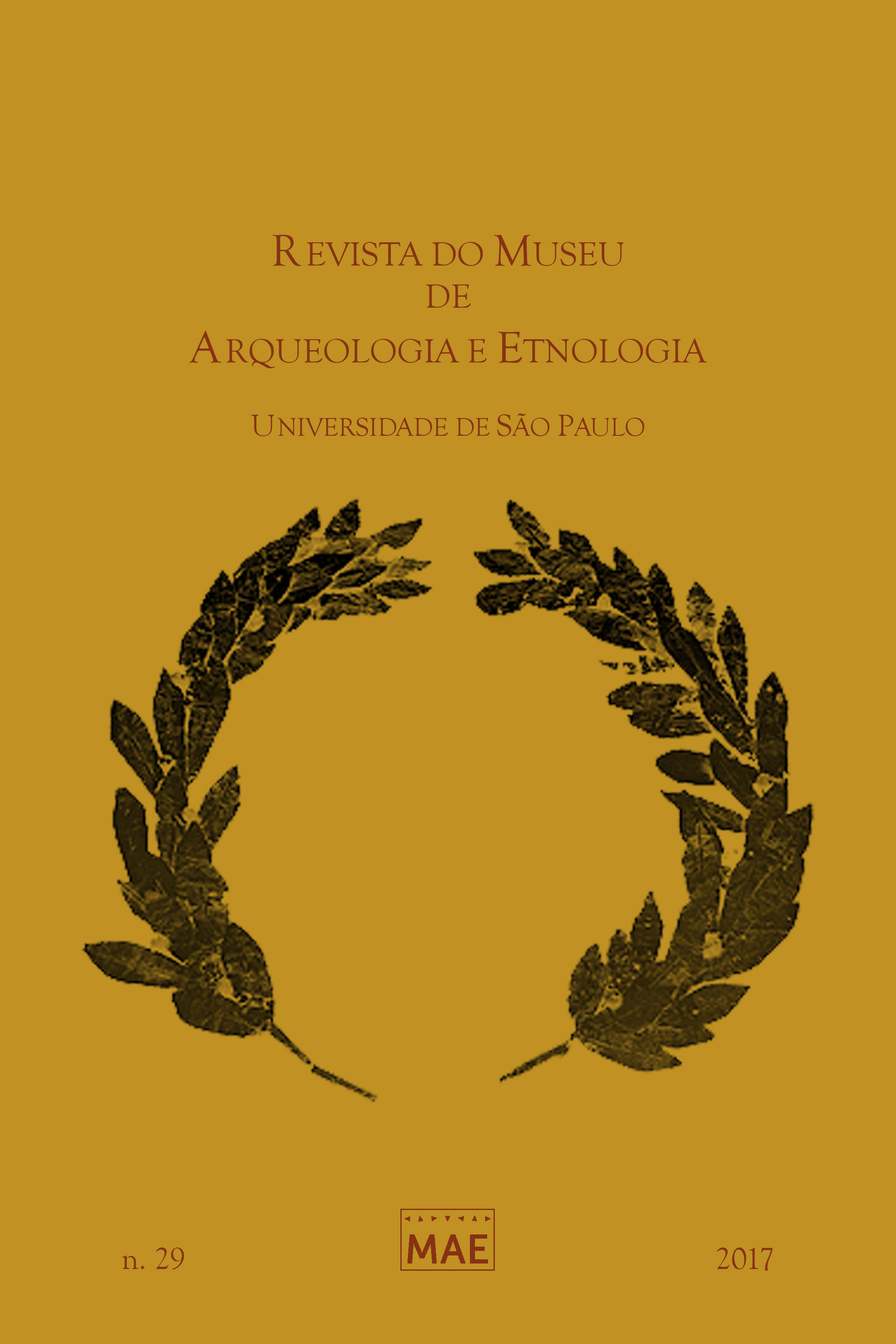The trumpet and the games
DOI:
https://doi.org/10.11606/issn.2448-1750.revmae.2017.148161Keywords:
Games, Classical antiquity, music, Salpinx, iconographyAbstract
The musical accompaniment of sports is an outstanding feature of games in ancient Greece, either in training or in competitions. This accompaniment was done with wind instruments, namely the aulos and the salpinx (trumpet). Such accompaniment of athletic activities with aulos, mainly in the modalities of the pentathlon, widely represented in the iconography of blackand red-figure Attic vases (6th and 5th century B.C.), has received more attention from scholars. We aim here to deal with the presence of the trumpet in games, represented with a lower frequency in iconography, but informed by literary sources dating from different periods, mainly from the imperial times (namely Plutarch, Athenaeus and Pollux). We will analyze the following situations: musical accompaniment of races (foot and chariot races), supporting the rhythm of the movements; awards ceremony; advertisements through the emission of signals, with communicative function; and competitions for trumpet players, in relation with the constitution of a social profile of this musician-athlete based on the fame of his well above average strength. This superlative strength, mixed with bizarre customs, makes him a popular type in the Hellenistic-Roman world
Downloads
References
Anthologie grecque. Épigrames funéraires et épigrammes descriptives. 1941. (vol. II) Tradução de Maurice Rat, Garnier, Paris.
Anthologie grecque. Épigrammes amoureuses et épigrammes votives. 1938. (vol. I) Tradução de Maurice Rat, Garnier, Paris.
Athenaeus. 1927. The Deipnosophists. Translated by Charles Burton Gulick. Harvard University Press, Cambridge, MA.
Ennius. The Annals of Quintus Ennius. 1925. Edited by Ethel Mary Steuart. University Press, Cambridge.
Pausanias. 1903. Pausaniae Graeciae Descriptio, 3 vols. Edited by Federico Spiro. Teubner, Leipzig.
Philostrate. 1858. Traité sur la Gymnastique. Texte grecque accompagné d’une traduction en regard et des notes par Ch. Daremberg. Libraire de Firmin Didot Frères, Paris.
Remains of old latin I, Ennius and Caecilius. 1935. With an English translation by E. H. Warmington. Harvard University Press, Cambridge, MA.
Seneca. 1962[1920]. Epistulae Morales. II. Books LXVI – XCII. Translated by Richard. M. Gummere. Loeb Classical Library, Londres.
Referências bibliográficas Bélis, A. 1996. Fanfarre d’appel aux armes. In: Annie Bélis, (Dir. musical), De la pierre au son. Musiques de l’Antiquité Grecque. (disco). Conjunto Kerylos. Direção musical: Annie Bélis. França, faixa 1, p. 7 (encarte).
Bélis, A. 1986. La phorbeia. Bulletin de Correspondance Hellénique, 110, 1, p.205-218.
Bélis, A. 1984. Un nouveau document musical. Bulletin de Correspondance Hellénique 108, p.99-109.
Bothmer, D. 1957. Amazons in Greek Art. Clarendon Press, Oxford, 1957.
Bowyer, C.S. 2016. Echoes of the salpinx: ancient Greek culture. Tese de doutorado. University of London Press, Londres.
Braun, K.; Haevernick, T.E. 1981. Bemalte Keramik und Glas aus dem Kabirenheiligtum bei Theben. De Gruyter, Berlim.
Crowther, N. 1994. The role of heralds and trumpeters at Greek Athletic Festivals. Nikephoros 7: 135-155.
Graef, B.; Langlotz, E. 1925. Die Antiken Vasen von der Akropolis zu Athen: Die Schwarzfigurigen Vasen. Archäologische Institut des Deutschen Reiches, Druck und Verlag von Walter de Gruyter & Co., Berlim.
Jüthner, J. 1968. Die athletischen Leibesübungen der Griechen, II: Einzelne Sportarten. Österreichische Akademie der Wissenschaften. Philosophisch- historische Klasse, Sitzungsberichte 249, 2.
Kefalídou, E. 1999. Ceremonies of athletic victory in Ancient Greece: an interpretation. Nikephoros 12: 95-119.
Kefalídou, E. 1996. Niketes: eikonographiké melete ton archaion helenikon athletismón. Editora da Universidade Aristóteles, Tessalônica.
Landels, J. 2002. Music in Ancient Greece and Rome. Routledge, London and New York.
Larmour, D.H.J. 1999. Stage and stadium: drama and athletics in Ancient Greece. Nikephoros, Supplement 4, Weidmann, Hildesheim.
Lissarrague, F. 1987. Un flot d’images : une esthétique du banquet grec. Éditions Adam Biro, Paris.
Miller, S.G. 2009. The Berkeley Plato: from neglected relic to ancient treasure, an archaeological detective story. University of California Press, Berkeley.
Moretti, L. 1957. Olympionikai: i vincitori negli antichi agoni olimpici. Accademia nazionale dei lincei, Roma.
Nordquist, G. 2014. The Salpinx in Greek Cult. Scripta Instituti Donneriani Aboensis, 16: 241-256.
Rocha, R. 2010. Um introdução à teoria musical grega. In: PLUTARCO. Obras morais: Sobre o afecto aos filhos; Sobre a música. Tradução, introdução e notas por Carmen Soares e Roosevelt Rocha. Coimbra, Imprensa da Universidade de Coimbra, 2010.
Shapiro, H.A. 1992. Mousikos Agones: Music and Poetry at the Panathenaia. In: J. Neils (ed.). Goddes and polis: the Panathenaic festival in Ancient Athens. Princeton University Press, Princeton.
Sweet, W.E. 1987. sport and recreation in ancient greece: a sourcebook with translations. University Press, Oxford.
Tiverios, M.A. 2008. Perikleische Panathenäen: Ein Krater des Malers von München 2335. Computus Druck Satz & Verlag, Gutenberg.
Valavanis, P. 1990. La proclamation des vainqueurs aux Panathénées. À propos d’amphores pana- thénaïques de Praisos. Bulletin de Correspondance Hellénique, 114: 3325-259.
Vergara Cerqueira, F. 2018. ‘Melodia sangrenta’ (Anth. Pal. VI.159): a trombeta e a guerra na Grécia Antiga. Anos 90 25(47): 149-188.
Vergara Cerqueira, F. 2016. To march in phalanx, to jump with weights, to knead the bread, to tread the grapes. What is the aulos for? Archimède. Archéologie et Histoire Ancienne 3: 187-205.
Vergara Cerqueira, F. 2005. Esporte e música na Grécia Antiga: uma abordagem baseada na interface entre a iconografia dos vasos áticos e os textos antigos. Classica 17: 165-183.
Vergara Cerqueira, F. 2001. Os instrumentos musicais na vida diária da Atenas tardo-arcaica e clássica (540-400 a.C.): o testemunho dos vasos áticos e de textos antigos. 3 vols. Tese de doutoramento. Universidadede São Paulo, São Paulo, 2001.
West, M. 1992. Ancient Greek music. University Press, Oxford.
Yalouris, N. 1994. The Olympic Games in Ancient Greece. Ekdotike Athenon, Atenas.
Zimmer, K.B. 2015. Der Tübinger Waffenläufer: ein griechisches Meisterwerk aus der Zeit der Perserkriege. Kleine Monographien, Band 2. Universität, Tübingen.
Downloads
Published
Issue
Section
License
Copyright (c) 2017 Fábio Vergara Cerqueira

This work is licensed under a Creative Commons Attribution-NonCommercial-NoDerivatives 4.0 International License.













